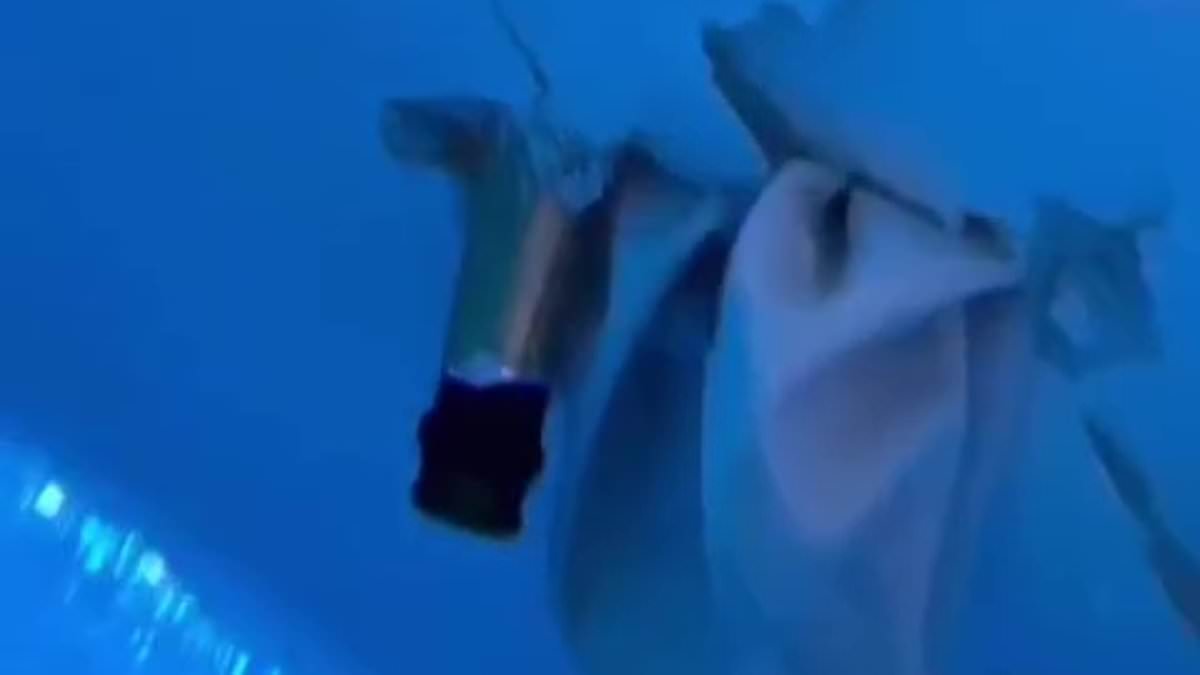They are usually deployed to christen a new ship.
But an enterprising transatlantic rowing crew told yesterday how they used an empty bottle of champagne to plug a hole in their vessel – after it was attacked and holed by a marlin.
The spear-nosed fish skewered the trio’s boat while they were partway through a 3,000-mile challenge called the World’s Toughest Row – puncturing the craft three times and breaking an oar.
Crew-member Maddie Difazio-Wright, from Bath, said the incident on New Year’s Eve was ‘utterly terrifying’.
‘I saw the fish coming at the boat and then we heard a crunch,’ she said.


An enterprising transatlantic rowing crew used an empty bottle of champagne to plug a hole in their vessel – after it was attacked and holed by a marlin

The spear-nosed fish (pictured) skewered the trio’s boat while they were partway through a 3,000-mile challenge called the World’s Toughest Row – puncturing the craft three times and breaking an oar

Crew-member Maddie Difazio-Wright, from Bath, said the incident on New Year’s Eve was ‘utterly terrifying’
‘It happened so quickly and our training kicked in we tried to utilise what we had on board to save our journey.’
She said the champagne bottle was left over from Christmas Day ‘so it was just instinct to use it to mend the hole’.
‘The poor marlin fish must have got a massive headache,’ she said.
Ms Difazio-Wright, a brand manager for a property company, and crewmates Grace Gilbert, a chartered surveyor from Oxford, and teacher Grace ‘G’ Pybus, from Newport, had no previous rowing experience and met up online to train for and take part in the challenge together.
The annual race sees competitors row over 3,000 nautical miles from La Gomera in the Canary Islands across the Atlantic to Antigua, and usually attracts 20 to 40 teams of up to five rowers from all around the world.
The women, who entered under the Vibe the Wave moniker, set off on December 12 and expected to take up to 50 days to complete the crossing.
They were making good progress until New Year’s Eve, when the trio realised they were rowing over a school of fish, which was being pursued by a 10ft (3m) long marlin.
In an incident captured on the crew’s GoPro camera, the fish rammed the boat with its spike-like snout, then returned for another attack. A team spokesman said it left ‘three notable holes’ – one inside the hatch with direct exposure to the ocean.

The crew said the champagne bottle was left over from Christmas Day ‘so it was just instinct to use it to mend the hole’

Ms Difazio-Wright, a brand manager for a property company, and crewmates Grace Gilbert, a chartered surveyor from Oxford, and teacher Grace ‘G’ Pybus, from Newport, celebrate the ‘world’s most remote cocktail party’ while on the boat

The crew had no previous rowing experience and met up online to train for and take part in the challenge together
The crew spent nearly three hours attending to the damage, and managed to patch up the boat enough to continue rowing using ‘a combination of a bucket, a fender, part of an oar and litter bags’ but are still taking on some water and are currently just under a month away from the finish line in Antigua.
‘We are still on track thankfully and making good progress on our journey’, Ms Difazio-Wright said.
The crew are equipped with dehydrated food rations and a water desalination unit, to make sea water safe to drink.
During the crossing, which was formerly known as the Talisker Whisky Atlantic Challenge, the women expected to row in excess of 1.5 million oar strokes, face waves up to 30ft (9m) high and contend with storms, blisters and bum sores.
The three women are using the Atlantic challenge to raise money for different charities.
There are several different kinds of marlin, with the largest being the kind which attacked the women’s boat, the endangered Atlantic blue marlin.
It can grow up to 16ft (5m) in length and weigh three-quarters of a ton.
The Ernest Hemingway novel The Old Man and the Sea is a story of an old fisherman’s battle to catch and land a huge marlin.
The tradition of breaking bottle of champagne or wine over a new ship’s bow for good luck and safe travel dates back to the days of the Vikings, who would pour a drop of blood from a sacrificed animal onto the ship’s bow for good luck.
